Samsung Fascinate Review: Verizon's Galaxy S Smartphone
by Brian Klug on October 5, 2010 12:01 AM EST- Posted in
- Smartphones
- Samsung
- Galaxy S
- Fascinate
- Mobile
Performance
Anand declared the Epic 4G the fastest Android phone. I think it's safe to say that right now the Galaxy S is the undisputed performance champ for 3D, at least until we start seeing SoCs built around A9 MPCore with even more powerful GPUs. CPU wise, Hummingbird is running the same architecture ARM Cortex A8 at 1 GHz that we've seen in other SoCs. For now, the Fascinate's Hummingbird SoC with the PowerVR SGX 540 GPU is really what sets it apart. It's a significant improvement over the SGX 530/535, and if you haven't already, I'd encourage you to read what Anand had to say about it in the Epic review.
That improvement is readily apparent in Quake III, where the Fascinate posts unsurprisingly similar numbers to the Epic.
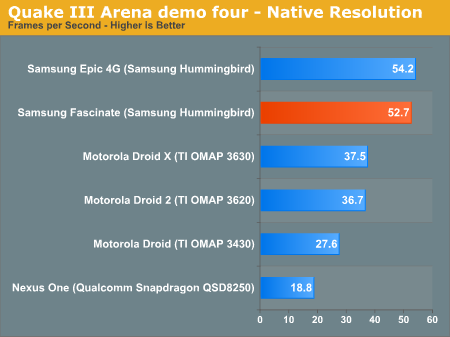
Likewise, we get similarly impressive Neocore numbers out of the Fascinate, which is Qualcomm's benchmark for showing off Adreno.
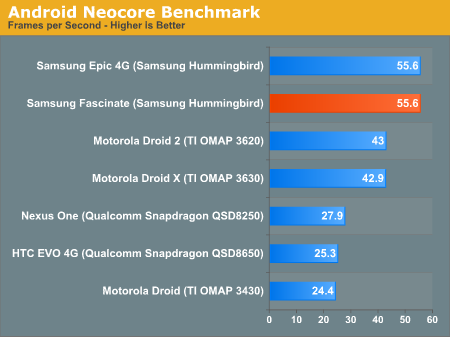
Though most of Android still can't take advantage of the SGX 540, applications that are rendered using OpenGL do show a massive performance boost. The qualitative difference between the stock Android gallery application on the Nexus One compared to the Fascinate is huge. On the Nexus One, it feels occasionally slow and choppy, yet on the Fascinate it's beyond smooth.
When the Android UI finally gets GPU acceleration, that huge performance gain will be readily apparent in everyday use instead of locked away for 3D apps and games.
Of course, our CPU-bound tests show almost exactly what you'd expect from a 1 GHz Cortex-A8. Bear in mind the Fascinate is running Android 2.1 as of these tests, but you can see how much Android 2.2 changes things - in some places.

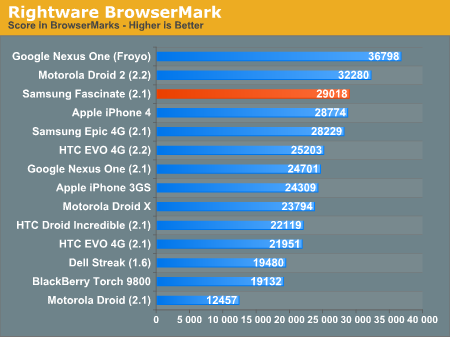
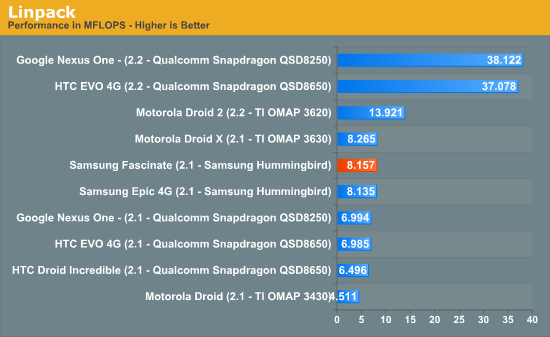
As an aside, I talked in the Droid 2 article about how I didn't quite understand why Linpack performance on Android 2.2 on the OMAP 3620 SoC wasn't what I expected it to be. The comparison I was using was to all the smartphones I had previously seen with Android 2.2 - all of which were Qualcomm Snapdragon SoC based with Scorpion CPUs at the core. The Droid 2 was my first encounter with a relatively standard Cortex-A8 running Android 2.2 with the JIT/NEON optimizations.
As some of our readers noted, the reason that Linpack performance on the Droid 2 isn't as high is simple - Scorpion has faster FPU performance due to a 128 bit SIMD FPU datapath compared to Cortex-A8's 64 bit implementation. Both FPUs process the same SIMD-style instructions, the Scorpion just happens to be able to do twice as much, or optionally turn off half the datapath to save power.
The reason I bring this up is that we won't see as dramatic a change in benchmarks that are FPU/NEON heavy moving from Android 2.1 to 2.2 on the Fascinate. Modest gains are in order all around, but not the dramatic floating point performance boost that really doesn't translate into huge performance gains elsewhere.
I've also been doing the regular suite of page loading tests. Though the Fascinate lacks Flash and the faster browser that 2.2 brings, it renders pretty quickly:

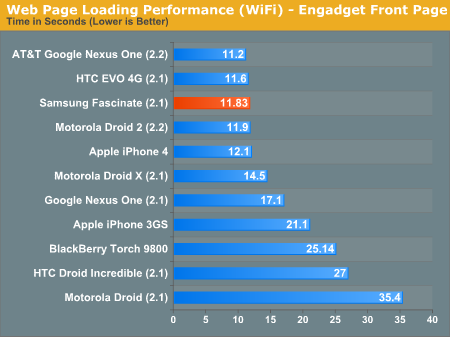










73 Comments
View All Comments
Ethaniel - Tuesday, October 5, 2010 - link
Good thing you directly recommend rooting and flashing the device. That Verizon-pseudo Google-Bing combo is kinda creepy... and bloated.medi01 - Tuesday, October 5, 2010 - link
"Outside readability in practice is improved from the Nexus One. "Dare I ask whether it is improved from, God forbid, iPhone 4? :rolleyes:
deputc26 - Tuesday, October 5, 2010 - link
In the performance page,Loading Engadget Times
EVO Should be 2.2 not 2.1.
Brian Klug - Tuesday, October 5, 2010 - link
I haven't included numbers from the EVO running 2.2 yet, although I've got them and will do so, those are current for 2.1 (as marked) ;)-Brian
Shlong - Tuesday, October 5, 2010 - link
it seems the Epic with Sprint is the best out of the Galaxy S line.alovell83 - Tuesday, October 5, 2010 - link
The Korean Galaxy S would beg to differ. FF cam + DMB. Yes, you do lose out on 4G, but you save hundreds on the life of the contract and it isn't as much up front either. Out of those available to the U.S. it's the $10 4G tax, without necessarily receiving a 4G signal which is the bummer, but you still get the best kit subsidized state-side. Living in a 4G city, the Epic is a no-brainer. Outside, we are talking about $300 more, assuming you don't get an amazon $.01 deal which would bump the contract life of the Epic to more than $400 more than the others...just for a FF camera and (cross you fingers, hopefully) to one day get a 4G signal in your city is just asking for too much.silverblue - Tuesday, October 5, 2010 - link
I have the UK version of the Galaxy S, and it's quite odd how many variants are out there. Differences on the UK version:1) no LED flash
2) sports an FF cam
3) the micro-SD slot is on the left inside the back, with the SIM card to the right and the built-in micro-SD above that
4) the buttons are confined to Menu on the left, Back on the right, and a physical Home key in the middle
5) the headphone socket has a black plastic surround instead of chrome effect (strangely, the review states 18mm - shouldn't that be 35mm?)
6) there's a "with Google™" logo on the back along with the SAMSUNG logo but no mention of Galaxy S; there's no mention of the carrier.
7) the phone weighs less at 118g
8) The default wallpaper isn't a Live one
deputc26 - Tuesday, October 5, 2010 - link
Interesting and yes that should be 35mmBrian Klug - Tuesday, October 5, 2010 - link
Yeah, I meant 3.5mm, 1/8 inches. Fixed ;)-Brian
chemist1 - Tuesday, October 5, 2010 - link
The single most important function of a phone is to, well, be a phone, i.e., do voice communication. And one of the characteristics most important to voice communication is the audio quality---both sending and receiving (via the earpiece or a headset; the percent of time spent listening via speakerphone is, for most, is less than for the earpiece or a headset). Yet, in a very long and otherwise thorough review, I could find only one sentence that addressed earpiece audio quality:"Earpiece performance and volume is adequate - voice quality is as good on the Fascinate as I've seen on other CDMA handsets in the testing I performed."
And I could find no mention of audio quality from the headset jack, nor any mention of audio quality for someone on the receiving end of a call from this phone.
It's sort of like reading a detailed review of a new camera, in which lots of attention is given to metering, focus, etc. (all parameters that affect image quality), but with only a single sentence on how good the images are after metering, focus, etc. is dialed in. Likewise, you have several paragraphs on issues that affect audio quality -- e.g., the dependence of signal attenuation on how the phone is held-- but again, only one sentence on how good the phone actually sounds (and nothing on how good I sound to someone I'm calling) after these secondary effects are taken care of. I.e., suppose I'm receiving a call under ideal conditions (say, it's from a land line, there's a strong signal, I am holding the phone optimally, etc.). In that case, do you mean to tell me that someone with a trained ear would hear no difference in audio quality when listening through the earpieces of different CDMA handsets? While this may be true, I certainly would not be convinced of that based on reading just your one sentence, since it does not give the impression that a serious attempt to assess audio quality has been made.
As you can likely tell, I'd like to strongly suggest that, in future reviews, the comparative audio quality of these phones is addressed in a more serious and discriminating manner, by someone with extensive audio expertise and a highly trained ear. The reason your site is so well-respected is because it brings an unusual level of sophistication to computer hardware reviews. I’d like to see that same sophistication applied to audio performance, when you are reviewing devices where audio performance should be central (phones and portable music players).
I've been following this site for many years, and I think you folks are the best --- you do a fantastic job. But your expertise is computers, it's not audio. And often, when you venture into audio, I don't see it approached it with the level of sophistication with which you approach computer hardware. You can see your site's extraordinary sophistication with computer hardware with, for instance, Anand's perspicacious reviews of SSDs, in which he identified 4K random read and write speeds (as opposed to sequential large-block performance) as being the key to real-world performance. Yet, by contrast, when Anand was reviewing the audio perfomance of the iPod Nano, he just cookbooked the standard set of Rightmark Audio Analyzer measurements (http://www.anandtech.com/show/3903/apples-ipod-tou... he didn't demonstrate the audio expertise to first listen, and then make an informed decision of which measurements needed to be done. If he had, he might have realized that problems lie in areas that would only be revealed by a different set of measurements. Anand then went on to say "I believe we've hit a ceiling for PMP audio playback quality." Well, no, it could still be improved quite a bit. It is informative to contrast how Anand approached audio with, for instance, Marc Heijligers' astute analysis of iPod audio performance, at: http://homepage.mac.com/marc.heijligers/audio/ipod...
[I did mention this in the comments for Anand’s review, but it was towards the end of the thread, so they may not have been noticed.]
I suspect that, if you want the audio component of your reviews to be up to the high level of sophistication you show for computer hardware, you're going to need to bring in someone with years of audio expertise and a highly trained ear.
Thanks for listening to this very long comment!